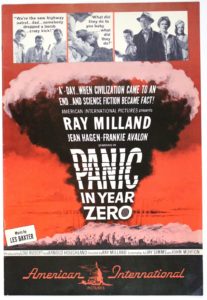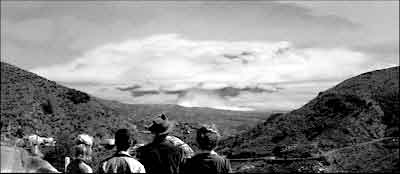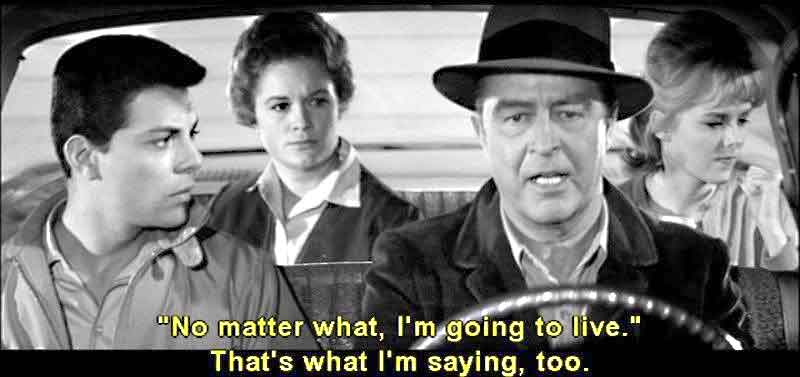 This 1962 classic is a stark and disquieting look at a socio-economic breakdown in the wake of a nuclear attack. The chillingly convincing narrative of primitive survival and director/star Ray Milland’s overriding conviction make for an unforgettable exercise in Cold War paranoia that remains pertinent today.
This 1962 classic is a stark and disquieting look at a socio-economic breakdown in the wake of a nuclear attack. The chillingly convincing narrative of primitive survival and director/star Ray Milland’s overriding conviction make for an unforgettable exercise in Cold War paranoia that remains pertinent today.
PANIC IN YEAR ZERO!, produced by American International Pictures, is often lumped into the modern Nuke Movie cycle typified by downbeat dramas like THE WAR GAME, THREADS, THE DAY AFTER, etc. In fact, PANIC IN YEAR ZERO uses a nuclear attack merely as a springboard for a frank look at the limits of civilized behavior in a lawless society, making it part of the Breakdown-of-Civilization subgenre, and easily the best of the bunch (others include Cornel Wilde’s NO BLADE OF GRASS, which is too preachy, and Michael Haneke’s TIME OF THE WOLF, which is too pretentious). The overriding message seems to be that despite the trappings of civilization we’re not too far from our cavemen ancestors, to which end the film has the protagonist and his family actually take up residence in a cave.
PANIC IN YEAR ZERO uses a nuclear attack merely as a springboard for a frank look at the limits of civilized behavior in a lawless society,
The late Ray Milland, an Academy Award winning actor (for Billy Wilder’s 1945 classic THE LOST WEEKEND), made his impressive directorial debut with PANIC IN YEAR ZERO. Sadly, it was to be the only time he directed a movie, with the remainder of his career devoted to playing cardboard villains in potboilers like ESCAPE TO WITCH MOUNTAIN and FROGS.
Harry Baldwin (Milland) is a suburban everyman on a camping trip with his wife and two teenage kids. Driving through the mountains surrounding Los Angeles with their camper in tow, the Baldwins are shocked to see several mushroom cloud explosions on the horizon; the radio informs them that the commies have attacked and civilization is in ruins. Harry springs into action, stopping off at a small town grocery store and buying up most of its stock, with the clunky family camper proving quite useful in storing it all. After this Harry cleans out a nearby drug store, but is stymied when the owner won’t accept his check; a fight ensues, during which Harry and his son overpower the man and hightail their way out.
 From there it’s a brutal and unforgiving odyssey through lawless mountain terrain, with Harry finding himself committing several morally questionable actions in conjunction with his tripper happy son, who appears to be enjoying the mayhem a bit too much. They use gun shots to disperse a crowd, clear a busy highway by starting a fire (nearly burning several motorists to death in the process) and destroy a bridge so no one can follow them to the campsite that is their goal.
From there it’s a brutal and unforgiving odyssey through lawless mountain terrain, with Harry finding himself committing several morally questionable actions in conjunction with his tripper happy son, who appears to be enjoying the mayhem a bit too much. They use gun shots to disperse a crowd, clear a busy highway by starting a fire (nearly burning several motorists to death in the process) and destroy a bridge so no one can follow them to the campsite that is their goal.
it’s a brutal and unforgiving odyssey through lawless mountain terrain, with Harry finding himself committing several morally questionable actions…
Once at the campground the Baldwins take up residence inside a cave and find, to their chagrin, that the drugstore owner Harry assaulted is encamped nearby, and that a gang of homicidal teen punks have also shacked up in the vicinity. The punks kill the drugstore owner and his wife and rape Harry’s daughter, which naturally inspires Harry and son to hunt the scumbags down and stop ‘em for good…but in the brawl Harry’s son is wounded and the family, now bearing an extra member in the form of a comely young woman liberated from the clutches of the now-dead punks, is forced back onto the highway in search of medical assistance.

Although it bears many of the pratfalls afflicting low budget movies of the early sixties–stilted staging, flat compositions and a tendency towards overwrought melodrama—PANIC IN YEAR ZERO presents an admirably sober, clear-eyed view of social anarchy. It also boasts a (rare) decent performance by Frankie Avalon in a supporting role and an excellent one by Ray Milland in the lead, who demonstrates a sternly patriarchal attitude that was very much in keeping with the mores of the time, in which the father commands and his wife and children unquestionably do his bidding. That’s not a criticism, just an observation, although I can say that such attitudes are one of the few ways in which the film has become dated in the years since its initial release.
PANIC IN YEAR ZERO presents an admirably sober, clear-eyed view of social anarchy.
Far more distressing is the low budget, which makes its presence felt on several occasions, most notably the freeway fire, a shocking sequence rendered somewhat less so by a series of too-tight shots and mismatched stock footage (evidently a view of the freeway, the fire and the protagonists all in the same shot was out of the scope of the budget). Nevertheless, the film really works, bringing power and integrity to a story that could have easily degenerated into exploitive hokum.
Vital Statistics
PANIC IN YEAR ZERO!
American International Pictures
Director: Ray Milland
Producers: Lou Rusoff, Arnold Houghland
Screenplay: Jay Simms, John Morton
Cinematography: Gilbert Warrenton
Editing: William Austin
Cast: Ray Milland, Jean Hagen, Frankie Avalon, Mary Michel, Joan Freeman, Richard Bakalyan, Rex Holman, Richard Garland, Willis Bouchey, Neil Nephew, O.Z. Whitehead, Russ Bender, Shary Marshall, Hugh Marlowe
